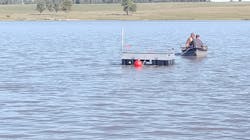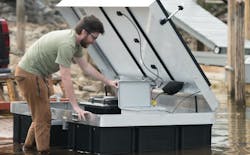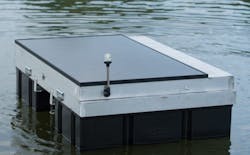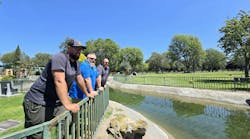As problems associated with algal blooms increase across tens of thousands of lakes, reservoirs, ponds, and managed wastewater repositories, cities and utilities are taking a number of measures to mitigate the issue. Historically, chemicals were the go-to solution — however, due to their cost and potential for environmental harm, they are not a good solution for many environments.
Left untreated, harmful algal blooms (HABs) threaten health, infrastructure, property values, and recreational pursuits.
Algae requires sunlight and nutrients, such as phosphorus and nitrogen, to proliferate. The primary sources of nutrients for algal blooms come from fertilizer runoff, phosphate-based cleaning detergents and surfactants, and overuse of algaecides (particularly copper sulfate).
Over time, these anaerobic bacteria cause the algae problem to spiral out of control by continually recycling phosphates back into the water column. Cyanobacteria, also known as blue-green algae, feed on the phosphates expelled by anaerobic bacteria. Cyanobacteria also create complex hydrocarbons that are toxic to humans and many other animals.
While spring and summer see widespread growth of algae, a large increase of blooms also occur after summer has warmed the sediment levels in a water body. The sediment holds much of the undigested organic food laden with phosphates that have settled since the last winter season (leaves, dead plants, etc.).
These undigested phosphates typically lay in the bottom area of a body of water, where oxygen levels are low. It is also in these areas that the coldest conditions exist, lagging behind air and surface temperatures as summer warming continues.
Typically, in the northern hemisphere, the bottom areas reach a temperature that is high enough for anaerobic bacteria to become very active generally from late June to the middle of July, depending on the latitude and the number of sun hours per day. Once this temperature is reached, the anaerobes become very busy eating the muck and expelling a large volume of phosphates.
A Holistic Approach
Addressing nutrient levels is an important process in the short- and long-term reduction of HABs. This means regular testing of all influents and sections of the water body to determine the source of nutrient pollution, after which remedies can be applied.
While every body of water is unique with its own influents and ecosystem, it is becoming increasingly evident that a holistic approach — involving both nutrient and algae control — can be very effective at providing a rapid, long-term solution to the problem. In addition to reducing nutrient levels, it is also important to consider aeration systems, good green algae, and ultrasonic mitigation.
Next-generation ultrasonic algae mitigation systems can be extremely effective. The newest systems transmit more than 2,000 frequencies, which ensure that the proper and most effective resonance is applied to emerging or well-established algal blooms. The applied frequencies emit ultrasonic sound waves, which travel through the water only and cause both structural and fatal damage to the targeted blooms. The wide frequency range of ultrasound proves very effective in treating most algae, while causing no harm to zooplankton or fish. In addition to the frequency output of an ultrasonic anti-algae system, the mechanical design of most advanced systems incorporate algae repellent surfaces. This reduces the chance of biofouling, which could otherwise harm the effectiveness of these systems.
Today’s systems are autonomous and equipped with solar energy to power all onboard systems. Additionally, internet of things (IoT)-based components are designed to provide performance and reliability over many years of use.
It has been estimated that approximately 95 percent of the 70,000 species and two million sub-species of algae are affected by ultrasound. Most often, this technology can pre-empt an algae bloom and keep it from spreading further. SW
Published in Stormwater magazine, May 2022.
About the Author

George Hutchinson
George Hutchinson is the CTO of WaterIQ, an algae mitigation company specializing in ultrasonic solutions.




